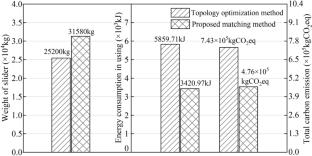A large number of carbon emissions are generated in the life cycle of metal forming equipment. The movable components are the critical part of the mechanical system in the equipment, which accounts for the carbon emissions in both of manufacturing and use stages. Reducing carbon emissions of the components in the manufacturing stage by lightweight design may result in a significant increment of emissions in the use stage. To overcome the obstacle, a method of matching the mechanical system of metal forming equipment to reduce life cycle carbon emissions is proposed. The effect of the weight of the components that determine the manufacturing’s emission on the configuration of the drive units that determine the emission in the usage stage, was analyzed and quantified. Then, the drive units were reconfigured and optimized to meet the required output force and velocity with the different weights of the components to find the optimal scheme with the lowest emissions in the life cycle. The method was applied to a 2000-ton hydraulic forming equipment, and results indicate that 14.87% of the weight of the movable components can be reduced with a total carbon emissions reduction of 22.48%. The total carbon emissions were reduced by 35.94% compared to that of the movable components through the topology optimization method. The proposed matching method can assist in the low-carbon design of the mechanical system in metal forming equipment.



